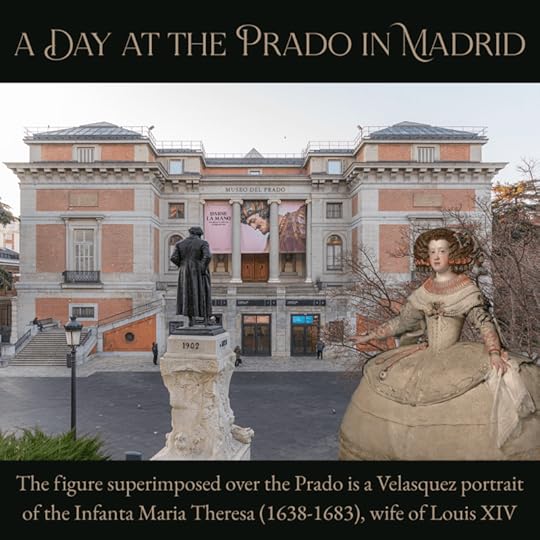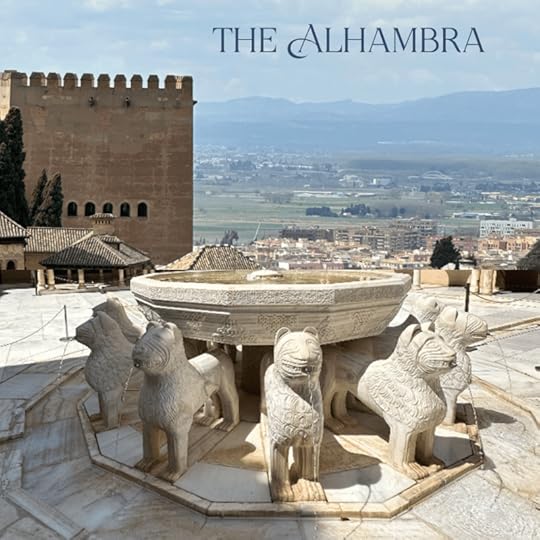Cynthia Sally Haggard's Blog: Cynthia Sally's Blog, page 4
August 4, 2025
A Day Visiting El Escorial ~ The Monastery-Palace built by Philip II of Spain
This turned out to be a long and exhausting day. I decided to go for inexpensive in the various options available for me to get to El Escorial, the Monastery-Palace built by Philip II of Spain. First, I took a taxi to the Moncloa bus station in Madrid (cost €9.05 or $9.95).
After alighting, I found a passerby who seemed friendly. Unforuntately, he spoke almost no English, but I understood I was to go down the escalator. At the bottom, a massive crowd came together. On closer inspection I realized they were at Door 10, waiting for either the 661 or the 664 to El Escorial, so I joined the line. A 661 appeared almost immediately, and the Spaniards walked in an orderly fashion towards it, but when it became evident it was going to be packed, some people ahead of me formed a line for the next bus. So I joined them because I didn’t want to sit in the back.
We had to wait ten minutes for the next 661 bus, and about two minutes before it was due to leave, it opened its doors and we got on. I gave the bus driver €5 in cash, and he gave me back 80 cents as the cost was €4,20 (cuatro venti). This is about $4.65. Because of my place in line, I was able to sit in the second seat from the front (right hand side) in the window seat. We left at 8:00 and goodness, the traffic was bad. The trip to El Escorial was supposed to take 55 minutes, but I think we actually arrived at 9:05.
Because I had plenty of time, I looked around the El Escorial bus station, trying to make sense of it. I figured out that the place where the bus dropped us off was only a dropoff point, and not where you would stand to catch the bus. I went into the waiting room, and the electronic board told me which bus was the next to leave, and how many minutes (or hours) the next ones left. But it didn’t tell me where to stand to wait for the bus. So I found a pedestrian walkway that wound down, and figured out where the buses were parked. A 661 left Bus Stop Number One on its way back to Madrid, and so I decided I would head there after my tour of the Escorial.
I walked out of the bus station to the palace, and because the 661 bus had already passed it on its way to the bus station at El Escorial, it was easy to find. But at 9:30 in the morning everything was quiet and shut up. Which I found disturbing as it was supposed to open at ten. Where were the lines of tourists? No-one was in evidence.
I actually walked past the palace entrance, going through a courtyard that had no exits. I passed one sign that seemed to suggest that it wasn’t the entrance, and so I walked around the whole complex, coming eventually to a car park that led to the gardens. All this time I’d been following various people who’d been walking rapidly, like they knew where they were going, and I thought they were tourists. But at the car park I hesitated. There were (as usual) no signs, and so I pulled up the Moovit app, and discovered I had walked past the entrance.
I retraced my steps to the forbidding and empty courtyard. The Moovit app directed me to a door that was now open. But the sign told me that it was a school and the entrance was private. So I walked back around the courtyard, back to the door with the unhelpful sign (which was now half open) and realized that this was the correct place.
The man there said they were not open yet (it was 9:45 by this time) and advised me to cross the courtyard to sit on a low wall. I did this, and then realized that I was heading towards a Tourist Information office. I followed the arrows, but the office was closed and would not open until 10:00. And so I walked back to the half-open door, where quite a few people were rushing in, (nearly late!).
Finally, the bell tolled ten and I was the first person to be let in. But the female guard at check-in told me I would have to put my backpack in a locker. So I had to find the locker. Then I realized that in order to get the locker to lock, I would need a €1 euro coin, which (of course) I didn’t have. So I was directed to a shop, and for two 50 cent coins, the woman there gave me €1 euro. Back to the locker, I put my backpack inside, and used the coin to lock it. The key came smoothly out, but there was nothing on the key to tell me which locker it belonged to. (The Spanish really hate signs!) And so I used my iPhone to photograph it, so that I would remember it was Locker 38.
The next task was to get an audio guide. I met a man standing in the courtyard with one, and fortunately he spoke English, and told me where to get it. For an extra €5 euros, I had some guidance. It seemed to be helpful, had various languages to choose from, and various routes to take. I chose the 2-hour tour and at first everything went well. I loved the library, even though it was a very steep climb up to it, and consequently a very steep climb down. (My knees didn’t thank me.) But somehow, I failed to get into the church. Instead I found myself in the Chapter House. Following the arrows which told me where to go, I descended several steep steps which took me into the crypt of the Escorial, where all the tombs were. There were several tombs of Philip II’s wives and his close family members. Then there was a structure that looked like a giant white marble cake. It contained all the tombs of the children who had died before puberty. I turned left and followed the white marble tunnel, passing many rooms on the left, each one full of tombs, such as the tombs of Isabel II’s relatives, before having to clamber down more steep stairs to a round room with all of the tombs of the Kings of Spain.
It was really creepy and claustrophobic, and the Spanish obsession with death made me want to flee. I asked the guard where the gardens were, but she didn’t speak English. I had to clamber up more stairs to nearly the top of the palace, where I met a young man who did speak some English. He told me that I was about half way along, but it would take me 45 minutes to complete the rest of the tour.
By this time, I was exhausted. The constant climbing I had just done was causing my tachycardia to kick in. My knees weren’t happy. And I had to pause to catch my breath. Once I’d done so, I had to climb up even more steps to continue with the tour. At the top, I encountered a room full of tapestries about battles. From there, I was able to walk relatively swiftly through the royal apartments, (I really hate dark gloomy rooms with musty furniture) until I saw a sign that said Salida, meaning exit. I was so relieved! I followed the signs and found myself coming downstairs near to the lockers. I retrieved my backpack, gave the audio guide back to the young man by the bag check, and asked the way to the gardens.
When I exited the palace, I found myself opposite the Tourist Information Center, so I went there and asked them about getting to the gardens. The woman there was most helpful, handing me a map and telling me exactly how to get there. The entrance was nearly all the way to the car park where I’d hesitated that morning. Because I was now feeling so tired, I just walked to the gardens, and took a few shots. But the gardens were the highlight of the tour, with the mountains providing a stunning backdrop. After that, I saved my energy for walking all the way back to the Bus Station.
I went to Bus Stop One, only to find the 669 there. As there were (again!) no signs, I walked alongside the buses looking for the 661 or 664. But I was so lucky. Just as I got to the end, a bus pulled in and it was the 661 to Madrid. Again, I gave the bus drive €5 and this time I must have gotten €3,70 in change because the ticket only cost €1,30. As before I sat in the second seat from the front on the right hand side and the bus drove us back to Madrid in less than an hour. (It left at 12 Noon and got in at 12:55.)
As we entered the bus station, I looked to my right and saw a line of taxi cabs. So after we arrived, I took the escalator up to street level, turned left and handed the first taxi the Hotel Wellington business card. However, by this time Madrid was busy, swarming with hordes of tourists. So it took the taxi driver about 30 minutes to get me back to the hotel, and even then she had to leave me off two blocks away. But she repeatedly gave me instructions on how to get to the hotel. (The cost of the ride was €13,00 or $14.29.)
Returning to my room, I collapsed. Then I got up, packed my suitcase for my trip to Luxembourg tomorrow, before going down to join the others for the Farewell Dinner held at the hotel. What a wonderful time I had during my Odysseys tour of Spain and Portugal!
 The post A Day Visiting El Escorial ~ The Monastery-Palace built by Philip II of Spain appeared first on Cynthia Sally Haggard.
The post A Day Visiting El Escorial ~ The Monastery-Palace built by Philip II of Spain appeared first on Cynthia Sally Haggard.
August 1, 2025
P IS FOR PERIL by Sue Grafton
The novel opens when Fiona Purcell, ex-wife of Dowan Purcell, hires Kinsey Millhone to investigate her ex-husband’s disappearance. It’s been nine weeks since Dr. Purcell left the nursing home that he runs, disappearing at around 9pm after chatting to one of the inmates, an elderly lady who plays an important role in this novel.
Where is he? No-one has found the car he was driving, or his body.
As many fans of Kinsey Millhone know, she is an expert in insurance fraud. And sure enough, there is plenty of that going on by a couple of nefarious characters, who are eager to shift the blame onto Dr. Purcell. Then there are his two wives. Fiona, Wife Number One is suitably bitter at her lot in life. She doesn’t spend money wisely and stands to gain quite a bundle on the good doctor’s death. And then there is Crystal, Wife Number Two, who was originally married to an abusive man, divorced, and then married to Dr. Purcell. Purcell is 69, she is 29 and they have a 2-year-old son together. Crystal is the person who shows the most emotion over her husband’s strange disappearance. She seems to be very upset. But then she has so much to cope with in the shape of her fourteen-year-old daughter Leila, who is just as obnoxious as any teenager can be. Yes, Crystal herself was a teenaged mother, being only fifteen when her daughter was born. Leila leads her family a merry dance. She is confrontational with her mother, and makes no secret of her deep-seated dislikes for her stepfather, Dr. Purcell.
But the P for Peril is really about none of this, but instead a promising dalliance that Kinsey finds herself ensnared in, when the charming Tommy Hevener appears on the scene, and starts to woo her. Of course Tommy and his twin brother Richard are not what they seem, and what follows is a spiral downward from seeming politesse and rationality, to much darker places.
Although I see why many readers complained that this novel didn’t end, for me, it wasn’t a problem. The novel fades out with Kinsey having wine with Crystal and her best friend Annika. The three women sit on the porch chatting, seemingly having a good time. But only the reader knows that they are waiting for Rob Jordan, a cop that Kinsey knows, to arrive. And when he arrives, the reader knows that Reality is going to come crashing down. For Crystal is going to have the shock of her life when she realizes that her only daughter Leila, together with the connivance of best friend Paulie (a hardened criminal), has stolen thirty thousand dollars that belonged to her late husband Dowan Purcell. But that is not all. For the reader also knows that the person responsible for Dowan Purcell’s death lives at Crystal’s house.
 The post P IS FOR PERIL by Sue Grafton appeared first on Cynthia Sally Haggard.
The post P IS FOR PERIL by Sue Grafton appeared first on Cynthia Sally Haggard.
July 29, 2025
A Day in Madrid
Today was supposed to be a half day of touring with the afternoon off. But due to the difficulties of getting tickets at the Prado Museum, it turned into another full-day tour.
We left at 9:00 am in the morning, and our local guide gave us a coach tour of the highlights of Madrid. After that, she took us to El Pardo, a hunting-lodge-turned-palace on the outskirts of Madrid. I must say I was glad to be out of the city. After arriving yesterday and seeing the hordes of tourists, I really didn’t feel like doing any shopping, or spending any time in Madrid. So it was wonderful to be outside in the countryside on yet another perfect morning, bright and cool.
I don’t much care for palaces, as I think that those who inhabit them usually exhibit very poor taste. So I was happy to spend some time in the gardens. Except that the gardens, such as they were, were not particularly well-tended having only three blooming trees and no flowers.
After that, we went on a walking tour of Old Town Madrid. Again, I was not very impressed with the place. This was borne out by the tapas lunch we had in a local restaurant near the Plaza Mayor. It just wasn’t very good. I really don’t like croquettes (especially as it is usually hard to tell what is in the middle of the fried outer shell.) And I really didn’t want to eat raw eggs over squid. And so I passed on a couple of the offerings.
After that, we drove to The Prado Museum. I left my backpack on the bus, and we went in for our timed tickets at 3pm. Our tour guide told us that he was giving those of us who wanted to drive back to the hotel in the bus two hours to enjoy it.
Oh dear, it was so hard to find things. Finally, I realized that the room numbers in most (but not all) the rooms were up high on the wall. Then I had to use the map to puzzle out how to get from Room 9 to Room 51. There seemed to be no logical order to the numbers, and so every time I’d finished with a painting I had to peer at the map to decide where to go next. Needless to say, the 2-hour tour was taking much longer than it should have. It would have been so much better if there had been instructions on how to get from one painting to another. Of course, there wasn’t. I lasted one and a half hours before being completely wiped out. However, I have to say that The Prado has a stunning collections of masterpieces, and I would like to come back to see more. I ended up in the Velasquez room, and got distracted by all the pictures of those women in their farthingales.
By 4:35, I was asking a couple of guards for directions to the way out. I dumped my audiophone in the plastic tray they had, and descended the outside stairs. I was so happy and relieved to see Norberto with the coach, and enjoyed the 5-minute drive back to the hotel before collapsing into my room.
 The post A Day in Madrid appeared first on Cynthia Sally Haggard.
The post A Day in Madrid appeared first on Cynthia Sally Haggard.
July 25, 2025
A SMALL TOWN IN GERMANY by John Le Carré
Although this novel has its flaws (it could do with some editing), it paints such a vivid picture of the greyness of cold-war Europe. In particular, Le Carré delineates how the provincial town of Bonn, which was the capital of West Germany between 1945 and 1989 was the most boring place in the world. Especially for diplomats and their wives.
John Le Carré’s talent as a writer is very evident in this novel. He begins with a long description of the almost daily fog, the mists that coil up from the river Rhine and blur everything into an impentrable greyness. This description of the mist serves as the perfect metaphor for the goings-on at the British Embassy.
One thing I really didn’t know was that there was strong anti-British sentiment in Europe during the 1960s. In those days, Britain was trying desperately to get into the Common Market, but the rise of the Right in Germany, with its anti-British rhetoric seemed destined to scupper Britain’s chances. And so, during this novel, the British Embassy is in a state of continual panic. Add to that the mysterious disappearance of a German-British man called Leo Hartiing, and the situation is rife with tension.
Harting, a charming man who makes most everyone feel too comfortable around him, has not only seemingly vanished off the face of this earth, but he has also made off with a file of Top Secret documents, that if they got into the wrong hands would cause considerable embarrassment for the British. So why isn’t the British Embassy doing more to find him? The British Ambassador, Rawley Bradfield is strangely reluctant to find Harting, and in fact has made no effort at all to retrieve him or his file of embarrassing secrets. In fact the first that anyone actually notices that Harting is not around, is when they go to Church on Sunday, only to find that their organist – in the shape of Harting – is missing.
Bradfield is content to leave it at that. And would have done so had not the Foreign Office sent a stubborn Yorkshireman with a talent of putting people’s backs up to Bonn to fiind out what on earth is going on. I supppose you have to be British to appreciate what happens next. For top diplomats in Britain, like British Ambassador Rawley Bradfield, are typically those born with silver spoons in their mouths. This means an priviledged education at Eton (or Rugby, or Marlborough), followed by a stint at Oxford (or Cambridge), and maybe a tour of duty at the Sorbonne or Leipzig. In other words, these people hail from the south of England, whose culture is oriented towards Paris. And too many of these same people are pretentious snobs. Then we have The Excitable Welshman, a pal of Harting’s, who is very fond of going on in his sing-song accent about how marvelous Harting is. Lastly we have that stubborn Yorkshireman, whose name is Alan Turner. As a Yorkshireman, he hails from the North of England, which has a completely different culture from the South of England. Far from being oriented towards Paris, the denizens of The North are Proudly British , and have no time for snobs, or pretensions, or anything like that. It is no surprise that Turner annoys British Ambassador Rawley Bradfield from the get-go, as they parry insults in that typical duel, of typical English Class Warfare.
I told you that Turner was stubborn, and he is. Against the express wishes of the British Ambassador, he breaks into Harting’s house and overstays his welcome. But he does succeed in finding out exactly where Harting is, and why he disappeared. It is extremely amusing to watch him spar with his social superior (Bradfield) and in his very down-to-earth way get to the bottom of all the skeletons in the British Embassy closet.
If you have never read John Le Carré before, you might want to try this one.
 The post A SMALL TOWN IN GERMANY by John Le Carré appeared first on Cynthia Sally Haggard.
The post A SMALL TOWN IN GERMANY by John Le Carré appeared first on Cynthia Sally Haggard.
July 22, 2025
A Day in Toledo, Spain
Monday was the second of two very long days. This time, we had to travel from Úbeda, where we’d staying in the Parador of a 16th-century palace. How can I possibly complain about the Wi-Fi when we are staying in such a stunning building? It didn’t help it was under repair (EU funding) making it hard to appreciate its beauty.
We arrived in Toledo at 12:45, so the first order of business was lunch. I walked along a street crammed with tourist shops, but wasn’t coming up with anything promising. As I was looking, a couple from our tour group appeared, and so we found a place and had lunch togehter. The man had a burger and fries. I picked a dish from Toledo, because the Google translation of the Spanish said it was pork in a mild tomato sauce. And so his wife picked it too. It was delicious.
After that, we had our tour of Toledo. But I was so exhausted from yesterday’s visit to the Alhambra that it took all of my willpower to go along on the tour and not bow out. We visited the huge Gothic Cathedral that was consecrated in 1493, just after the Reconquista. Thankfully, our guide said she was only going to show us the highlights. Then we visited the 14th-century church of Santo Tomé, to see the El Greco portrait on the wall. The place was heaving with Japanese tourists, and we had to wait our turn before we could get a decent picture. Then we visited the Synagogue. Finally, she led us down out of town (Toledo is on a high hill) to the Tajo river, which was replete with brown, rushing water due to the recent rains. On the other bank of the river, away from the tourist tat, crowds of schoolchildren, and poor lunch offerings, I could finally appreciate what a beautiful town Toledo is.
At 5:00 pm, we left Toledo, and drove to Madrid, which took us an hour and a half. Finally we arrived at our very fancy hotel, The Wellington Hotel & Spa in the upscale Salamanca neighborhood of Madrid, and got our room keys. Naturally the elevators, in this Art Deco palace of a hotel, didn’t wish to work. There were two lifts. But if you pushed the up button of Lift A, while Lift B still had its doors open, then you delayed Lift B. Finally, I figured out what was going on, and after some coaxing, I was finally in my room. I would have been totally knackered had I not had a piece of very yummy chocolate cake, that woke me up!
 The post A Day in Toledo, Spain appeared first on Cynthia Sally Haggard.
The post A Day in Toledo, Spain appeared first on Cynthia Sally Haggard.
July 18, 2025
ELEGY FOR EDDIE ~ MAISIE DOBBS #9 ~ by Jacqueline Winspear
When a delegation of costermongers, all clothed in their best, shows up at Maisie Dobb’s office one morning, she is at first bemused. Why are they here? Surely they know that they will each lose money as their appointment cuts into their working hours. Whatever it is must be serious.
And it is, to them.
A “simple” man has recently been killed at a paper factory, crushed by something too heavy falliing on him. The management, naturally, says this was an accident. These men are not so sure. While they may not claim it to be out-and-out murder, nevertheless, something seems wrong.
Jacqueline Winspear, the author of the MAISIE DOBBS series, writes with such empathy about people who are different. Eddie, the simple man, the character of the title of this volume ELEGY FOR EDDY, is the product of a rape between a shadowy assailant, and a 16-year-old girl from the workhouse. Maudie Pettit was so shattered by her experiences growing up in that workhouse, that she works mightily at whatever she is given to do, to ensure that she always has enough to avoid going back there. We learn about Eddie’s birth early on in the novel, and because Maudie would have lost her job if her pregnancy had become known, she has to birth Eddie in secret on a bed of hay surrounded by horses.
It turns out that Eddie, although slow in so many ways, has some outstandiing gifts. He is a genius with horses, always able to calm down even the most high-strung and aggressive. As he is generally good-natured and always willing to help, he acquires a group of fans, who stand up for him when life becomes difficult.
He can do mental arithmetic with great facility, so that even though his Mama insists on his writing down everything he’s earned, actually, he doesn’t need to do that as he can always remember ~ to the nearest farthing ~ exactly how much he has earned. As this is in the days when British coinage was in Pounds, Shillings and Pence, this is quite a feat.
It is not until the end of the novel that we learn about another of Eddie’s outstandiing skills ~ his ability to take in an image and copy it later from memory. And it is this ability that gets Eddie into trouble. For this good-natured man is not going to understand that some images are secret, and there are plenty of powerful people who will try to stop him from copying those images.
 The post ELEGY FOR EDDIE ~ MAISIE DOBBS #9 ~ by Jacqueline Winspear appeared first on Cynthia Sally Haggard.
The post ELEGY FOR EDDIE ~ MAISIE DOBBS #9 ~ by Jacqueline Winspear appeared first on Cynthia Sally Haggard.
July 15, 2025
Visiting The Alhambra in Granada Spain
Today was the beginning of two long days of travel. Our coach left at 9 am and took three hours to travel the 188 km (117 miles) west to Granada. Once we arrived in Granada, our local guide arrived and we had to show our passports as well as our tickets for the Alhambra. Unfortunately, in this day and age, people can buy up tickets very fast (within 30 seconds) and sell them on for a tidy profit. And so the Alhambra in Granada and the Mesquite in Cordoba require all visitors to show their passports, so that they can verify who owns the ticket.
After that palaver, we entered the complex. I hadn’t realized that The Alhambra was a village. Nor that there were so many private houses. Or that it had two streets! But we couldn’t have hoped for a better day to explore. It was gorgeous, everything green from the recent rains (it rained during the whole of March), and vibrant with birdsong. We entered first into a suite of rooms that everyone had to pass through in order to visit the Sultan. The throne room was very dark, but apparently was constructed in such a way that a beam of light came in just behind the sultan. This meant that the sultan himself was in shadow, but the faces of the ambassadors standing in front of him were illuminated, giving the sultan quite the advantage.
After that, we went into various different palaces constructed at various different times, and saw the various gardens with their Arab design, which meant that water was the main element. One had a reflecting pool that was the inspiration for the one at the Taj Mahal. Others had small fountains playing in scalloped shell-like bowls.
But the highlight for me was the Lion’s Court. When I’d visited back in 2015, they were doing major renovations, which meant that it was not possible to walk around and really see it. That convinced me to come back, and I’m so glad I did, because this time I was able to examine the lions, and I discovered that they pushed the water out through their mouths. Our bus driver, Noberto from Portugal, told me that they told the time. For there are twelve lions, and when one is pushing out water, it is 1am/pm. When two are pushing out water, it is 2 am/pm. And so on.
At the end of the tour, some of our group decided to sit out the tour of the Generalife Gardens, but I went along, if only to re-experience their beauty, plus the stunning scenery of the Sierra Nevada that provides a backdrop to the wonderful buildings that make up the Alhambra complex.
Needless to say, I took masses of photos. What a wonderful day!.
 The post Visiting The Alhambra in Granada Spain appeared first on Cynthia Sally Haggard.
The post Visiting The Alhambra in Granada Spain appeared first on Cynthia Sally Haggard.
July 11, 2025
THE STABBING IN THE STABLES by Simon Brett
I love the way that author Simon Brett increases the difficulty of the challenge he faces as an author, as he ups the stakes of writing craft during the Fethering series.
In this volume of the Fethering series, THE STABBING IN THE STABLES, it is made vivid to us how amateur sleuths are at the mercy of a lack of evidence, a lack of forensic analysis and a lack of the whole police procedure apparatus that detectives enjoy.
So when Jude finds the dead body of a man in the local stables, who has been stabbed, she has to spend most of the novel wondering what the police think of this mysterious death.
But that does not make this novel boring. Far from it, for the amateur sleuth pair of Jude (last name infrequently given) and her neurotic side-kick Carole Seddon are resourceful ladies, who manage to eventually figure out what is going on, sans police help.
Jude is a healer, and as the novel goes along she realizes that there is something very wrong with one of her clients Sonia Dalrymple. Sonia is connected to the stable world of West Sussex via her love of horses, but she frequently calls on Jude because she is in so much pain, she can scarcely move. Jude starts to notice a pattern in these problems. Sonia seems much more relaxed when her husband Nicky (an international banker) is away from home on one of his frequent trips abroad. When he is actually present, Sonia’s problems return. In the meantime, Carole strikes up a friendship with the self-absorbed Hilary Potter, whose teenaged daughter Imogen has a passion for horses,
Through such two disparate lines of inquiry, Jude and Carole are able to determine who really stabbed Walter Fleet and who is responsible for the “horse-ripper” mutilations of the mares in the surrouding countryside.
Although Simon Brett is a man, he writes with great sensitivity about women, including domestic violence (Sonia’s husband Nicky regularly beats her up) and divorce. Hilary Potter and her husband Alec are moving inexorably towards divorce, and the whole tension and drama around it are having a really negative effect on their teenaged daughter Imogen. There is no way to really make vivid to someone who has not experienced divorce just how devastating it can be for the child caught in the middle of it. As children have very little agency, they are forced to watch, helpless, as their family breaks apart. It is like having the rug pulled out from under you. It is like watching your house collapse, until it is a rubble of broken bricks and jagged stabs of glass. Nothing seems certain, everything seems chaotic, and the child in the middle often assumes that they must have done something terrible to bring this on.
This is the situation that thirteen-year-old Imogen finds herself in. She is not helped by her self-absorbed mother (whom she hates) or her unreliable father (whom she adores.) Not surprisingly, she is a very angry young lady who cracks under all this emotional pressure. Everything comes to a head near the end of this novel, which author Simon Brett manages to solve in a very satisfactory way.
 The post THE STABBING IN THE STABLES by Simon Brett appeared first on Cynthia Sally Haggard.
The post THE STABBING IN THE STABLES by Simon Brett appeared first on Cynthia Sally Haggard.
July 8, 2025
Ronda
Today we went on a walking tour of Ronda, with local guide Marta. By now, the howling wind and pouring rain of yesterday had ceased, and the weather improved. Nevertheless, it was cold enough (48 degrees) for me to wear my puff jacket as we set out at 9:30. Marta first took us to the bullring, left over from the 18th century and talked a lot about bull fighting. Then she took us to the Alameda del Tajo. Alameda means “promenade” in Spanish and Tajo is the name of the river and also means “cut.”
I walked all the way along the marble promenade to the end, and poked my head over the side. The view was absolutely breathtaking. Apparently the name Ronda means that is is surrounded by mountains and even today, communication between Ronda and other towns is not easy. And one can see why, for there is this enormous plunge down to a boiling river below. Marta told us that we were 300 meters up from the surrounding countryside, or about 1000 feet.
After taking some wonderful photos showing the morning mist,we walked along the escarpment back into town, over the New Bridge (from 1795) and into the Old Town, where we visited the Cathedral and various palaces (all with lovely gardens boasting beautiful views of the surrounding mountains) and back through a charming square (the Plaza de Maria Auxiliadora) from where the footpath descends to views up of the New Bridge with the waterfall.
We had an hour to rest, and then we had a Tapas lunch at the Parador de Ronda where we are staying. After lunch, I zipped off back across the New Bridge to the Mural of Romanticism, then just past that, left and down to visit the Old Bridge (built in the Renaissance) and the Roman bridge. I must have climbed down one thousand feet to see it. Of course, I thought the Roman Bridge was the Renaissance Bridge, which is still very high up from the boiling stream below. Of course, I was standing on the Roman Bridge which is still open to car traffic.
I didn’t stay long as I had promised to go on a walk that the Odysseys tour guide had organized for us, staring at 4pm. This time we went over the New Bridge as before, but on the other side of the road, turning right opposite the mural, and passing through a charming square before finding the footpath to the right that must have descended another one thousand feet.
Oh dear, I had to go slow as my knees were now bothering me. But I made it down all the way to the view (which, as promised, was of a steep waterfall falling from under the New Bridge) to find the tour guide waiting for me. I took some time for a breather, and then (of course) I had the task of climbing up yet another 1000 feet. Telling him to go ahead, I went up slowly, as slowly perhaps as I did on that trip to the Pyrennees, where Francois our guide had insisted that we go slowly up the very steep paths. Eventually, I made it to the top and was very pleased to see I was not out of breath. I spent some time taking photos of my charming square before heading back to the hotel, where I spent the rest of the evening resting.
 The post Ronda appeared first on Cynthia Sally Haggard.
The post Ronda appeared first on Cynthia Sally Haggard.
July 4, 2025
THE VIOLINIST OF VENICE by Alyssa Palombo
Although THE VIOLINIST OF VENICE bears an image of a young woman with a low-cut neckline on the cover, it is actually refers to Antonio Vivaldi (1678-1741), Priest, Virtuoso Violinist, and Composer.
Yes, Adriana d’Amato can play the violin, and that is how the novel opens when the 18-year-old society beauty finds a way of escaping her father’s oppressive mansion to go to Vivaldi’s house one midnight to beg for a violin lesson.
Vivaldi is impressed with the young woman. Although obviously out of practice (she has not had lessons since she was a child) Vivaldi can recognize a true musician when he sees one. This is someone who is not just technically proficient, not someone who can just play all the notes perfectly, but someone who can delve deeper and recreate the expressive power of the music.
And Adriana is impressed with Vivaldi. Although he is 14 years her senior, he creates the most glorious music in his compositions, and he is the violinist par excellence of Venice. Needless to say, it doesn’t take too long for these characters to fall in love and begin a passionate affair.
But we are in Venice in 1710. Young women from families with aspirations and the aristocrats they aped were not allowed to stray. Adriana’s father Enrico d’Amato is a wealthy merchant. He is not an aristocrat, but he has enough money to buy his daughter a marriage to an aristocrat. And so he locks his daughter up in her rooms, preventing her from participating in any society events, or even having any friends.
But he finds the perfect young man for Adriana in the shape of Tommaso Foscari, scion of an aristocratic Venetian family. Tommaso is about the same age as Adriana, and like her is passionately fond of music. He would have made the perfect husband for her except for the fact that by the time he proposes marriage, she is expecting Vivaldi’s child.
The tension and awfulness of Adriana’s situation ~ pregnant, lonely and entirely in the power of her father who doesn’t hesitate to vent his wrath upon her in a violent rage ~ is given full play by Ms Palombo’s powerful writing. But what I love about this novel is how everything that is so wrong for Adriana at age 18, becomes right twenty years later, when people are able to let the past go and forgive one another.
I see that Alyssa Palombo plays piano and sings, and that might be the reason for the one mistake I could find in this well-researched novel. The keys of C major and A minor are easy to play on the piano. But they are not so easy to play on the violin. Instead, the easiest keys on the violin are those associated with the open strings ~ G major, D major, A major and E major (although E major requires a lot of shifting because it is the top-miost string.) Perhaps this mistake can be corrected in a later edition.
 The post THE VIOLINIST OF VENICE by Alyssa Palombo appeared first on Cynthia Sally Haggard.
The post THE VIOLINIST OF VENICE by Alyssa Palombo appeared first on Cynthia Sally Haggard.
Cynthia Sally's Blog
- Cynthia Sally Haggard's profile
- 129 followers



